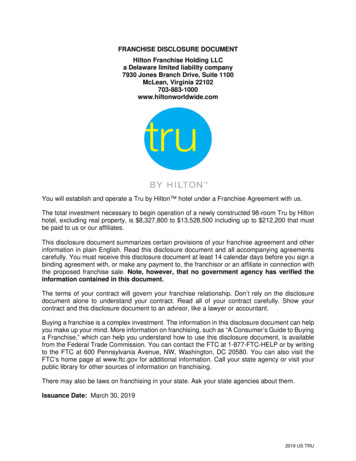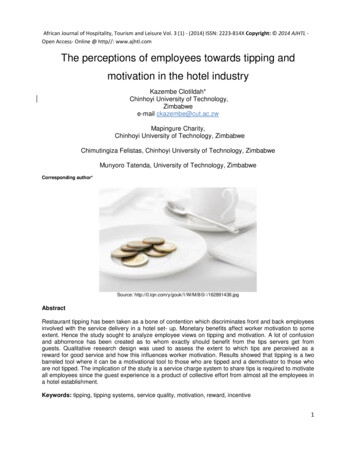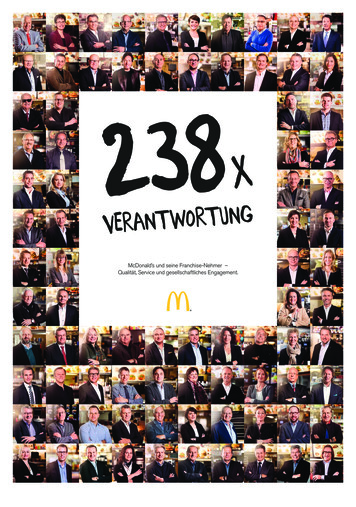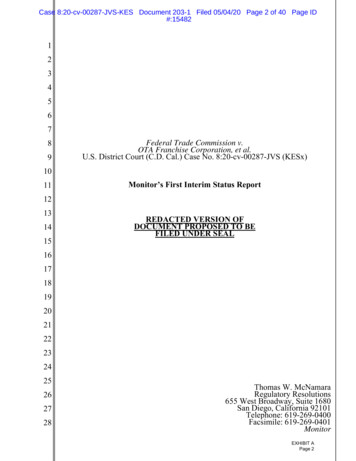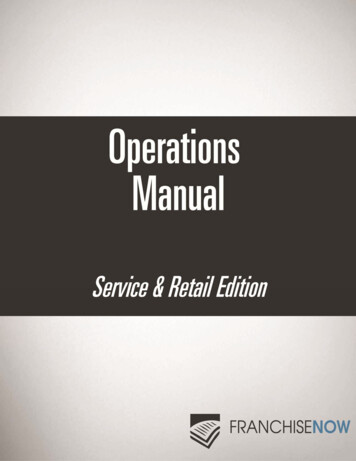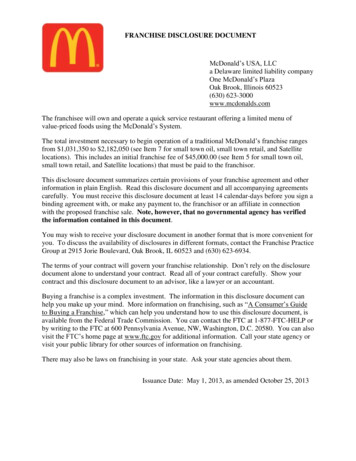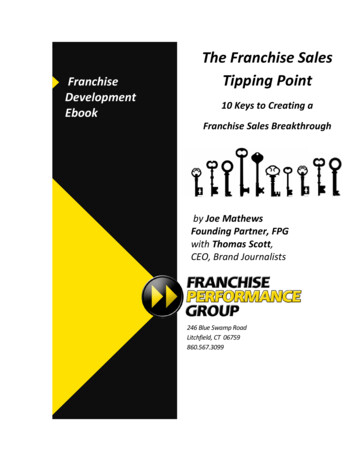
Transcription
eFranchiseDevelopmentEbookThe Franchise SalesTipping Point10 Keys to Creating aFranchise Sales Breakthroughby Joe MathewsFounding Partner, FPGwith Thomas Scott,CEO, Brand Journalists246 Blue Swamp RoadLitchfield, CT 06759860.567.3099
In an article in Time Magazine, reporter Bryan Walsh defines a “tipping point” as“the levels at which the momentum for change becomes unstoppable.”1Dictionary.com defines it as “a build-up of small changes that effects a bigchange,”2 like the proverbial straw which finally breaks the camel’s back. Theidea of the “tipping point” comes from the notion that wholesale change, such asaccelerated franchise sales growth, doesn’t really happen gradually, but occursat a climactic moment in time. If you buy into this idea, than you must alsobelieve you can design a franchise sales tipping point by identifying and puttingin place those key elements which work in concert to eventually burst open thefloodgates of opportunity.All iconic, category-killing franchise brands at one time have experienced afranchise sales tipping point. Most started out as small franchises and grewslowly, struggling as most franchisors do to find their next franchisee. Thensomething happened, the precise moment in the company’s history when thefranchise came out of obscurity and appeared to announce itself to the world,declaring, “We are now a force to be reckoned with.” If you’ve ever worked for acompany as it tipped, you will now remember it as the time when franchisecandidates seemed to already know who you are and want what you have beforeyou even have the chance to talk with them. It’s at this point that franchisecandidates seem to come out of the woodwork in droves, seeking to join thebrand.Before hitting their tipping point, these franchisors may have felt like they werepushing a rock up a hill in order to achieve their growth objectives. After they hitthe tipping point, however, these same franchisors often feel like they arechasing a runaway boulder down the other side of that hill, struggling to keep upwith the momentum.Now that’s a problem worth having!1A Green Tipping Point , Time Magazine Oct. 12, 20072Dictionary.com's 21st Century LexiconCopyright 2003-2010 Dictionary.com, LLC 2010 Franchise Performance Groupwww.FranchisePerformanceGroup.com2 o f 56
A Tale of a Tipping pointAfter graduating from the University of Connecticut in the spring of 1985, I read astory in the local newspaper about the CEO and founder of a 20-year old regionalsandwich franchise with almost 400 locations who was promising to become apowerhouse brand with over five thousand stores across the U.S. in the next 9years. Given that two weeks earlier I had received my freshly minted B.S. inMarketing from University of Connecticut, I thought they might benefit from myvast theoretical textbook marketing rhetoric. They bit; and offered me my first jobas a franchise salesperson.So it was that I started my franchise career with Subway in June of 1985. On mysecond day I received my first box of business cards, reading “Joseph E.Mathews, Franchise Development Manager.” Under that was the tagline “5,000restaurants by 1994,” a mere 9 years away.I remember thinking to myself, “It took us 20 years to get to 400; what makesSubway Co-Founder Fred Deluca think he will have 5000 units by 1994?” Iremember thinking: as soon as Deluca wakes up from his daydream, I will need anew box of business cards.Obviously, he proved me wrong. Deluca had brilliantly grasped the idea of a“tipping point” and the rest is franchising history. He knew Subway’s tipping point 2010 Franchise Performance Groupwww.FranchisePerformanceGroup.com3 o f 56
had come and he seized on the opportunity and drove the company to recordexpansion. Some of the contributing factors included:1. Low entry cost, relatively easy operations, and scalability of the model.Deluca created a proven franchise which worked on many different levels;everyone from the owner/operator to the empire builder could participate.2. Rise in immigration. Subway recruited aggressively within the Pakistani,Indian, and other Asian communities in the United States. Even thosewith limited English skills could still succeed as Subway franchisees. AsSubway’s story got out into these communities, their number of referralsgrew.3. Easy access to capital. Subway hit its tipping point before the Savingsand Loan collapse of the late 1980’s. Unlike today’s tight credit market,local banks and savings and loans were aggressively lending money inthose days. This made it easy for franchisees to get start-up andexpansion capital.4. Ascension of McDonald’s. Years earlier, Ray Kroc helped McDonald’s hitits own tipping point by branding a burger and proving what was possiblefor the food category. Investors then figured someone could also brand apiece of deli meat between two slices of bread. When I asked, “Why areyou looking at Subway?” many people explained, “I can’t affordMcDonald’sDSubway is the next best thing.” For franchisees, Subwaybecame “the poor man’s McDonald’s.”5. Perceived limited franchising options. This was before the Internet gaverise to franchise opportunity portals as we now know them. Researchingfranchise opportunities was difficult for most candidates and they oftenlimited their investigation to the brands with which they were alreadyfamiliar, perhaps via a first-hand consumer experience, or a news articlegenerated by PR, a visit to a trade show, or a recommendation by a friend.Most candidates had a very narrow perception of how many franchisebrands were out there and Subway quickly captured “front of mind” withpotential franchisees.6. Feet on the street. Deluca built a team of Area Developers (or“Development Agents” in Subway vernacular) in every major market in theU.S. Unlike other franchisors who sell the “green grass” and “blue sky 2010 Franchise Performance Groupwww.FranchisePerformanceGroup.com4 o f 56
areas,” Deluca awarded Area Developers to the early adoptingfranchisees that brought Subway franchise operations into virgin territory.7. Ego appeal of food service. At that time I used to joke, “There are only 3types of people. Those who want to write a book, those who want to go tolaw school, and those who want to own a restaurant.” People intrinsicallywanted what Subway offered.Today is a new era of franchising. Many of the external factors Subwaycapitalized on are no longer in place for franchisors in today’s market. Forinstance, the same Subway team using the same strategies which worked sobrilliantly with Subway failed to grow a series of other brands such as CajunJoe’s, We Care Hair, and Bagelz. Although these were decent brands lead byproven teams, Subways’ success formula proved to be a recipe for failure whenapplied to these other brands.As market conditions change, so has the strategy to create a tipping point. Andcreating one has never been more difficult. The reasons are as follows:First, there are more total franchisors than ever before fighting for the attention ofapproximately the same number of franchise candidates as before.Second, social media and the internet have robbed franchisors of their ability tocraft the franchise candidates’ first impression about the franchise business.Often candidates will stumble on information posted by a franchisee, customer,supplier, citizen reporter, or journalist before they visit the franchise opportunitywebsite.Third, investment capital is hard to come by for many potential franchisees.Many have seen their net worth slashed by more than 50% through acombination of the recent free-fall in the stock market and the cratering ofresidential real estate values.Fourth, candidates engage in more self-selection and personal investigation priorto being receptive to a personal contact from the franchisor’s representative.Simply put, candidates demand more transparency and easier access toinformation from the franchisor. The franchise salesperson is no longer thegatekeeper of information or exclusive teller of the franchisor’s story.Last, candidates are starting the franchise investigation process with lower levelsof trust than before, making establishing contact and creating meaningful 2010 Franchise Performance Groupwww.FranchisePerformanceGroup.com5 o f 56
dialogue more difficult for the franchise salesperson. The franchisorsalesperson, once counted on to be the franchisor’s appointed “trust agent of thebrand,” has been fired from that role by the franchise candidate. The franchisor’sconsumer and franchise opportunity websites, social media strategy, PRstrategy, and broker network community now act together in concert as thefranchise candidate’s initial trust agents.As you can see, creating a tipping point may be more difficult now than in pastyears, but it is still possible if you study the premise of “the tipping point” andidentify the few key areas that drive all franchisee recruitment results.Franchise Performance Group has been studying and creating franchise salestipping points since 2002. In this paper we will identify and explain the 10 Keysto Creating a Tipping Point. While these 10 keys apply equally to all franchisebrands, each franchisor will need to craft its own tactics for each key. If yousucceed in all 10 areas at the same time, when exactly your company will reacha tipping point is unpredictable, but I can tell you, based on my experience, it willhappen. Conversely, if you fail in one or more of these keys, regardless of howmany franchises you are selling now, your development program runs the risk ofcoming to a grinding halt.FPG’s 10 Keys to Creating a Tipping Point 1. Strong unit-level economics2. Solid franchisee validation3. Clear value proposition as a franchise opportunity4. Clear profile of a successful franchisee5. Intelligent franchisee recruitment process6. Cost-effective lead generation strategy7. Skilled franchisee recruiters8. Candidate-friendly financing9. Franchisee-centered, results-oriented corporate culture10. Effective Leadership ensuring great execution of the first 9 keys 2010 Franchise Performance Groupwww.FranchisePerformanceGroup.com6 o f 56
The purpose of this paper is not to flush out the winning formula for each key.We wish to leave the franchisors with a high level understanding of what eachkey is and where to focus their time, money, and talent to create breakthroughs.Key # 1: Strong unit-level economics.This single key is the greatest predictor of a franchisor’s futuresuccess! All enduring franchise brands are built on a foundation ofboth the consistent successes of its existing franchisees and almostcertain future financial successes of future franchisees. Bottom line: yourbusiness needs to be producing acceptable returns for the vast majority offranchisees according to the franchisees’ definition of “acceptable.” Also, thesesuccess stories need to be heard. Franchisors and franchisees need toaggressively share their stories.Right now many thousands of potential franchisees are searching online for away make a better life for themselves and their families. These candidates maynot contact you until they first satisfy three basic questions that every candidatehas: Does your business make money? Is the business sustainable? Will it continue to make money into theforeseeable future? Can I see myself in the business?If through your online presence, franchise candidates can predict your model willsatisfy these three concerns, you are much closer to your goal of filling yourfranchise sales pipeline with highly engaged and buyer-ready franchisecandidates. Remember, these candidates often reach these conclusions through“guesstimation” BEFORE they talk to you.If candidates can’t quickly and almost effortlessly determine that your franchisemodel satisfies these three concerns, they’ll quickly dismiss your opportunitybefore you have the chance to share the rest of your story. Most won’t ever fillout a lead form or call and you’ll never realize how close you might have been toyour tipping point. 2010 Franchise Performance Groupwww.FranchisePerformanceGroup.com7 o f 56
In the absence of credible information, human beings appear to be wired to makeup a worst-case scenario to fill in their information gaps. For instance, what doparents think whose teenager is out past his curfew and who doesn’t call home?Do they only believe, “He must merely be having fun and not paying attention totime,” or do they also entertain the possibility of a horrific accident?ImplicationsIf franchise candidates can’t research your opportunity online and find someevidence that your business model produces highly predictable long-termsustainable profits, they may automatically assume it doesn’t. If they can’t findevidence your franchisees are happy, then they may assume they aren’t.Right at this moment, somewhere in cyberspace, surfing the web are franchisecandidates who could and should buy your franchise but perhaps they haveeither dismissed or glossed over your opportunity because they wrongly assumeyour business model won’t work for them in the absence of information to thecontrary.Now we don’t want to oversell the value of financial performance. While it’s firstand foremost on the list of what people are looking for, there is in fact more to thelist. In his classic Harvard Business Review article entitled, “One More Time:How do you motivate employees?” Psychologist Frederick Herzberg found thatwhile an adequate income is critical to the satisfaction of an employee, money isby no means the only factor in this equation.3 On the one hand, Herzberg foundmoney to be an “all or nothing” yardstick for bottom line satisfaction. In otherwords, if the money is not right (by the employees’ definition of “right”), peoplewill discount all the other drivers and motivators, such as “making a difference,”“learning,” “new challenges,” “loving the work,” “flexibility,” “control,” and“personal achievement.”On the flip side, however, money alone typically isn’t enough to keep someone’sattention for very long. While many franchise candidates are unemployed orunder-employed, other candidates in the franchisor’s pipelines are alreadymaking a good living. However, aside from earning a steady paycheck, manycan’t find a compelling reason to go to work in the morning. Money alone isn’tenough to keep their heads in the game. As long as the other quality of life and3Herzberg, F. 1968, "One more time: how do you motivate employees?", Harvard Business Review, vol.46, iss. 1, pp. 53–62 2010 Franchise Performance Groupwww.FranchisePerformanceGroup.com8 o f 56
other drivers are available in your business model, many candidates will considertaking a short-term step back in earnings to experience the long-term quality oflife and financial benefits.Using a poker analogy, consider your financial returns as your ante to thefranchise poker game. If you don’t offer franchisees consistently strong returns,you don’t have the ante and therefore you don’t have a seat at the table.Carrying this logic forward, Item 19 and Financial Performance Representations(FPR) are more important than ever. Make this information as public and asaccessible as possible. On the PR materials, franchise opportunity website, andsocial media front (and under the scrutiny of your attorney), circulate storieshighlighting your franchisees’ financial success.Keep in mind there is no universal measure for financial success. The financialresults your opportunity predictably produces have to meet or exceed theexpectations of your target franchisees. However, in the present economy manyfranchise candidates seem to have higher financial demands than in the past.Those heightened expectations include: Rapid break-even. Many current franchise candidates do not have asmuch financial staying power as they have had in the past. Because oftheir depleted net worth, reduced available liquid assets, and possibleabsence of other sources of income, they often have less tolerance for riskand red ink. Many of the higher growth franchisors in today’s market arecrossing the break-even point before month 6 and are in sustainable cashflow positions by month 12. Replacement income. Many franchise candidates are willing to tightentheir belts for only so long. They want to get back to past levels ofearnings as quickly as possible. (Keep in mind “the way it was” is relativeto each franchise candidate.) I believe many franchise candidates need tosee a clear line of sight to “the way it was” between 13-24 months. Equity. Simply put, many of the franchisors we study produce littleappreciable equity value. Many franchisees or many systems are lucky tosell their business for the money they put into it. While cash flow seems tobe higher on the candidate’s radar screen than equity appreciation, webelieve more content and information than ever before is going to beposted by small business and franchising experts on blogs, online 2010 Franchise Performance Groupwww.FranchisePerformanceGroup.com9 o f 56
publications, and other forms of social media waking the candidate up toan important criteria they may be glossing over today.Action ItemsBite the bullet and create a FPR and introduce this information early in therecruitment process. Your target franchise candidates should find thisinformation attractive, enticing them to take a deeper dive into your recruitmentprocess.What is the typical entry cost for a new franchisee? What is the typical resaleprice of your existing businesses? Which is higher? If resale values are nothigher than a new franchisee’s entry cost, you have a unit level economicsproblem. Address it.How long does it take for a new franchisee to ramp up? If a new franchisee isnot crossing the threshold of break-even in 6-12 months, you may have a unitlevel economics problem. Deal with it.How long does it take for typical franchisees to replace their past income and“get back to normal?” If franchisees manage the business full time and cannotreturn to their past levels of income within 18-24 months, you may have a unitlevel economics problem. Take action.Many franchisors look at their top franchisees and say, “See? My model works.”Then in the next breath they dismiss the results of average and underperformingfranchisees, saying, “If they only followed the system, they would be winningtoo.” But that isn’t how franchise candidates or financial institutions look at it. It’sa simple fact that any franchise system of any scale has top performers who setthe bar for everyone else. Put these performers in most franchise systems andthey will replicate their success. On the flip side, each system gets infiltrated bysome franchisees that have the uncanny ability to prove time and time again thatthere is no such thing as “idiot proof.” So dismiss the results of the best and theworst, and focus on the middle. If your middle-of-the-road franchisee is notproducing acceptable results according to your typical franchise candidate’sdefinition of “acceptable,” then your growth will halt. If the franchisee is achievinga desirable outcome, then you are well positioned to hit your tipping point as longas you pay attention to the other 9 keys! 2010 Franchise Performance Groupwww.FranchisePerformanceGroup.com10 o f 56
Key # 2: Solid Franchisee Validation.How happy are your franchisees? In an honest and lucid moment,would they encourage other candidates to invest in your franchise ortell them to run like the wind? If given the chance, would they makethe same investment again themselves, or would they high-tail it in anotherdirection?And how do you know? Have you anonymously contacted franchisees to posethese questions, conducted a franchisee satisfaction survey, or are you relyingupon a gut feeling?FPG 80% RuleIf 80% or more of your franchisees do not indicate: they are either successful or expect to become successful according tohow the franchisees measure success, and they would make the same decision again today,you
Mathews, Franchise Development Manager.” Under that was the tagline “5,000 . Franchise Performance Group has been studying and creating franchise sales tipping points since 2002. In this paper we will identify and explain the 10 Keys to Creating a Tipping Point. While thes
